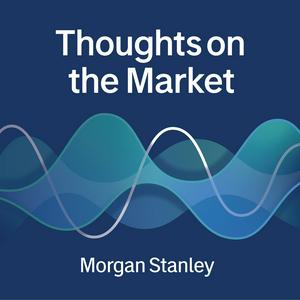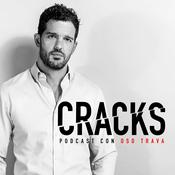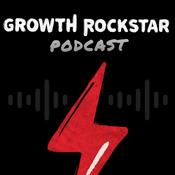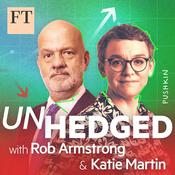Episodios disponibles
5 de 1518
- Stocks in 2026: What’s Next for Retail InvestorsMike Wilson, our CIO and Chief U.S. Equity Strategist, and Dan Skelly, Senior Investment Strategist at Morgan Stanley Wealth Management, discuss the outlook for the U.S. stock market in 2026 and the most significant themes for retail investors. Read more insights from Morgan Stanley.----- Transcript -----Mike Wilson: Welcome to Thoughts on the Market. I'm Mike Wilson. Morgan Stanley’s CIO and Chief U.S. Equity Strategist. Daniel Skelly: And I'm Dan Skelly, Senior Investment Strategist for Morgan Stanley Wealth Management. Mike Wilson: Today we're going to have a conversation about our views on the U.S. stock market in 2026, and what matters most to retail investors in particular. It's Monday, December 8th at 9am in New York. So, let's get after it. Dan, it's great to see you. We always talk about the markets together. I think this is a great opportunity for us to share those thoughts with listeners. Our view coming into this year is still pretty bullish for 2026. We've been bullish on [20]25 as you have, probably for, you know, similar – maybe some slightly different reasons. I think one of our differentiating views is that we do think inflation is still a major risk for individual investors. And institutional investors, quite frankly, which is why stocks have done so much better. A concept, I think you're well aware of. And I think, you know, the risk for retail is that there's going to be; it's going to be volatile. So, point-to-point, we're still bullish as you are. How are you thinking about managing that point-to-point path? And how are you structuring your portfolio as we go into 2026 with a bullish outlook – but understanding that it's not always going to be smooth. Daniel Skelly: So, like you said, we've also shared this view that next year's going to be positive, albeit there's going to be more volatility. And when I think about the two main risks that retail investors are facing today, one of them is definitely inflation. We're seeing that in services. We're seeing that in housing. We've had the labor market shrink over the recent couple of quarters, so who knows if wage inflation pops up again. But there are ways to definitely hedge against that in an equity portfolio. We think, for instance, owning parts of the AI infrastructure cohort is one of the ways of hedging, whether that be in utilities, pipelines, energy infrastructure in general. These are areas that we think are a necessary hedge against inflation risk. And number two are a positive diversifier. And second key point, Mike, just thinking about that diversification comment. Look, we all know that in many ways the Mag 7 – and the technology strength that we've seen this past year – has driven a fairly concentrated market. I think what people, particularly on the individual side, are recognizing less is just how much AI cuts across many other sectors in parts of the market. And again, we think that risk of over concentration is still out there. And we like the idea of thinking of embedding natural diversification into the equity portfolio. Mike Wilson: Yeah. I mean, it's interesting. Inflation, you know, is part of that story too because AI is somewhat disinflationary or deflationary. I think, you know, investing in things that can drive higher productivity even away from AI can mitigate some of that risk in the economic outlook. But if I think about, you know, the Mag 7 dominance, and just this concentrated market risk, which you spoke about. If inflation re-accelerates next year, which, you know, is one of our core views as the economy improves – doesn't that broaden out the opportunity set? And you know, like there's been this idea that, ‘Oh, you have to own these seven stocks and nothing else.’ I mean, part of our view for next year is that we think the market's going to broaden out. How are you set up for that broadening out? And how are you thinking about picking stocks and new themes that can work – that maybe people aren't paying attention to right now? Daniel Skelly: Yeah, it's a great point, Mike. And so, on the first topic, we do think there's broadening, and that's a combination of factors. Number one is just the market becoming more convicted about the Fed cutting path, which we've talked about, and the firm's view reaffirms for next year. Number two is starting to see some of the benefits of deregulation, right, which should impact maybe some of the more cyclical sectors out there – Financials, Energy being two of them. Maybe seeing more M&A activity too as a byproduct of deregulation. And that should bode better for mid- and maybe small caps as well as they receive a M&A premia in the valuations. And I know you've talked about small caps recently in your commentary. But last point I'll make Mike, and it comes back to AI. It almost feels like AI is this huge inflationary ramp at first to get to that deflationary nirvana down the road – with productivity. I think one of the key factors we think about, in terms of a bottom-up perspective, which is what we focus on in across the portfolio, is definitely pricing power. Who owns the pricing power and the key data and the key AI adoption outlook in order to absorb all the different tools and technology diffusion we've seen in the last three years. And that's going to play out, Mike, as you well know, across a variety of sectors and themes. So, agreed, we should see broadening for all those varying reasons. Mike Wilson: So, I mean, there are a couple areas I think, where we overlap. Financials…Daniel Skelly: Yep. Mike Wilson: Industrials, Healthcare, some of the themes that I think we both; we share our bullish views. And what do you think those areas are, within those sectors? You think that you have a differentiated view maybe than the consensus being Financials, Industrials, Healthcare? That the market may be missing, which offers more upset? Daniel Skelly: Sure. I'll start with Financials, which has been an overweight call for us for some time, as I know it has for you as well. And I think that kind of cyclical re-acceleration in the economy is one part. I think the Fed cutting is another part. I think deregulation is clearly another driver. Fourth Capital Markets recovery, which we have seen now. We had a little bit of a technical lull with the government shutdown in terms of filings and issuance, but we see all of the pipeline indicators, indicating green lights for next year in terms of recovery. I think the one thing I would argue that I've observed in looking at all of our vast data sets is that despite all these different bullish factors, this still maybe has been a theme or a sector that investors have traded in and out of, right? I don't think I've even seen like a real strong, consistent overweight. So, I think number one, that's an opportunity. And last point is, listen, there's different sub-sector bifurcation going on, as you know, within the industry, whereas money centers and large banks are performing really well. The same is not the case of regionals and alts managers. And there are varying reasons for that. But we would even argue, Mike, there could be catchup trades within the sector next year. Mike Wilson: Yeah, I would agree on that. I mean, the regional over money centers and actually regionals over alt managers, because I mean – I think the Treasury Secretary has talked about this, you know. Trying to get the regulated banking system kind of back in the game may actually be an opportunity to take share back from some of those alt managers, which have actually done quite well. What about on Healthcare? We upgraded that back in the summer. I think you've been constructive on parts of Healthcare, right. Wwhat do you think people are missing there and why could that be a good sector for next year? Daniel Skelly: Yeah. We were definitely, I'll say, earlier than you and wrong. You had really good timing in terms of your Healthcare upgrade last summer. And look, the sector was out of favor for two years. What we think we observed in the kind of July-August period is: First and foremost, I think we got past the point of maximum policy concern and risk. And ironically, we saw some kind of nominal or surface level deal signed with the government around most favored nation pricing. And it was really, not a lot to write home about. It wasn't as egregious as a policy inflection as some had feared. So, I think that was the first key catalyst. Second, we just saw a really good revisions breadth. And I know this is a comment you make a lot in your work. But we saw across big pharma, tools and life science, medical technology, and devices. We saw really good positive earnings revisions coming out of third and even starting the second quarter. Thirdly, I think if you're talking about an M&A in capital markets recovery, you can't not talk about Healthcare. I think that's a space that'll be ripe for deal making. And then just fourth, right? Look, as the market broadens out, and as people are stopping or maybe slowing the crowding and the key leadership, they're going to go again from AI enablers to AI adopters. And we think AI is going to be a vector that cuts across the Healthcare industry in a really positive way. Mike Wilson: Yeah, I mean, the efficiencies that are, you know, possible in the Healthcare sector seem immense. I mean, it, it appears to me that that's going to be an area where there's probably some new solutions, some new companies we don't even know about yet. So, to me that's a very exciting area that's been dormant for quite a while. What about Consumer, Dan? It's been this K economy. It's been very bifurcated, you know, high-end versus middle-income, lower-income. I mean, what are the themes within consumer that you're finding in putting to work in your portfolio? Daniel Skelly: Yeah. We've talked a lot, Mike, in the last year or so about playing Consumer platforms, particularly domestically oriented versus global consumer brands. And there's a couple of key drivers behind that. But first, when you look at what's going on in consumer land, and Simeon Gutman's been a really good, kind of, analyst looking at this theme over time. In many ways it's starting to resemble the Mag 7 in terms of winner take all phenomena. If you look at some of the major consumer big box platforms, they're taking 50- 60 percent of share of total retail sales. Just a couple of companies. So, number one, we're really focused on platforms where market share gains, free cash flow and revenue – recurring revenue – in particular, are leading to even stronger competitive moats, particularly in a capital-intensive industry. And what we've observed about retail is that as those leaders in big box areas take more share, they can reinvest that winning capital in their advertising growth in their online channel and widen their moats even more. Secondly though, in order to have a positive theme, I've always said you got to fund it from somewhere. And so, what we've observed again over the last year or so is – when I think about some of the even highest quality global brands they've suffered seeing less traction in China. And that's amid less of a willingness from Chinese consumers to own American and European brands. There's a lot to that, but I think culturally, obviously the trade war, the AI war for prominence leading to maybe some of that lack of cultural traction. Secondly, we've also, I think, started to see the growth of AI tools start to weigh on established brands. I think what makes a brand cool and the barriers to entry in terms of creating brands is going to go down in the future because of AI influencing and advertising tools. And so, simply put, we continue to like, Mike, the big box consumer platforms across, clothing and food, housing, across e-commerce. That continues to be one of our higher conviction themes. Mike Wilson: All right, Dan, I want to come back to, kind of, AI infrastructure. I mean, AI spending has been the big, big theme. But there's other types of infrastructure spend and CapEx. It's been dormant, quite frankly, and with the [One] Big Beautiful Bill [Act] perhaps incentivizing some of that. How does that play into your thought process around other industrial stocks that could benefit? Daniel Skelly: Absolutely, Mike. You cited the AI infrastructure spending. We think continues kind of unimpeded going into next year. Number two, we think the Fed cutting, just creating better financing conditions in terms of bigger projects. You mentioned as well, the fiscal incentives. And look, I think Chris Snyder has been spot on the last year or so talking about reshoring production wins coming back to the U.S. I don't think this is certainly as cognizant on the – or on the minds of individual investors. Maybe not even institutional investors. But the U.S. is winning manufacturing production share and has been for some time. And we've seen that no doubt ramp up post the announcement of the [One] Big Beautiful Bill {Act]. No doubt. But we think that has implications, Mike, for stocks and stock picking within what we would call, kind of, shorter cycle themes. And I think whether that be in Logistics and Transports or HVAC or some of the Non-Resi, Non-Datacenter related verticals. There are a whole bunch of stocks that have been kind of dormant for two to three years as we've been in this ISM recession that we think could certainly wake up next year as things broaden out. Mike Wilson: Yeah, we would agree with that. And I guess lastly, you know, there's always this Johnny come lately, you know, fear factor of, ‘Well … stocks are up a ton. My neighbor's bragging how much money they're making. So, I must have missed it all.’ And I think embedded within that is this fear of valuation. The valuations are now very rich. What's your response to individual clients about – it's not too late, they haven't missed it. It's still a bull market. In fact, we would argue a new bull market began in April with a new economic cycle. What is your response to those folks who have that angst? Daniel Skelly: Two things. One is the market today looks totally different than it did in the past, and AI is no doubt one big part of that. The composition of the market in many ways is higher quality, less debt, more recurring revenue. Big call option on productivity coming from AI earnings, power, et cetera. So, we think the market should trade at richer levels than it did in the past, point number one. Point number two, we would say whereas most people say time is your friend – for individual investors, they would also say valuation is no short term or short run indicator, but it's the best long run indicator. And looking at today's, again, extended levels of valuation relative to history – they would say that's not going to play out well over the long run. I would actually take the other side of that. I think that the earnings and the economic potential unleashed not just from AI, but some of these fiscal and monetary policies could create tremendous margin earnings potential in the long run. And so, I think today we're looking at a level of multiples that appears artificially high. And based on what could be a big earnings inflection point in that multi-year timeframe could frankly just be superficially high. Mike Wilson: Well, Dan, it's always great to get your perspective. I always enjoyed chatting with you. Daniel Skelly: Likewise. Mike Wilson: Thanks for coming on the show and sharing it with our listeners. It's great to see you. Daniel Skelly: Thanks Mike. Mike Wilson: And thanks to our listeners. Thanks for tuning in and let us know what you think by leaving us a review. And if you find Thoughts on the Market worthwhile, tell a friend or colleague to try it out.--------13:53
- AI Rewrites the Retail PlaybookLive from the Morgan Stanley Global Consumer & Retail Conference, our analysts discuss how AI is reshaping the future of shopping in the U.S.Read more insights from Morgan Stanley.----- Transcript -----Michelle Weaver: Welcome to Thoughts on the Market. We're coming to you live from Morgan Stanley's Global Consumer and Retail Conference in New York City, where we have more than 120 leading companies in attendance. Today's episode is the second part of our live discussion of the U.S. consumer and how AI is changing consumer companies. With me on stage, we have Arunima Sinha from the Global and U.S. Economics team, Simeon Guttman, our U.S. Hardlines, Broad Lines, and Food Retail Analyst, and Megan Clap, U.S. Food Producers and Leisure Analyst. It's Friday, December 5th at 10am in New York. So, Simeon, I want to start with you. You recently put out a piece assessing the AI race. Can you take us through how you're assessing current AI implementation? And can you give us some real-world examples of what it looks like when a company significantly integrates AI into their business? Simeon Gutman: Sure. So, the Consumer Discretionary and Staples teams went to each of their covered companies, and we started searching for what those companies have disclosed and communicated regarding their AI. In some cases, we used AI to do this search. But we created a search and created this universe of factors and different ways AI is being implemented. We didn't have a framework until we had the entire universe of all of these AI use cases. Once we did, then we were able to compartmentalize them. And the different groups; we came up with six groups that we were able to cluster. First, personalization and refined search; second, customer acquisition; third product innovation; fourth, labor productivity; fifth, supply chain and logistics. And lastly, inventory management. And using that framework, we were able to rank companies on a 1 to 10 scale. Across – that was the implementation part – across three different dimensions: breadth, how widely the AI is deployed across those categories; the depth, the quality, which we did our best to be able to interpret. And then the last one was proprietary initiatives. So, that's partnerships, could be with leading AI firms. So that helped us differentiate the leaders with others, not necessarily laggards, but those who were ahead of in the race. In some cases, companies that have communicated more would naturally scream more, so there is some potential bias in that. But otherwise, the fact pattern was objective. Walmart has full scale AI deployment. They're integrated across their business. They've introduced GenAI tools. That's like their Sparky shopping assistant. As well as integrated to in-store features. They talked about it. It's been driving a 25 percent increase in average shopper spend. They've recently partnered with OpenAI to enable ChatGPT powered Search and Checkout, positioning where the company, where the customer is shopping. They're also layering on augmented reality for holiday shopping, computer vision for shelf monitoring. LLMs for inventory replenishment. Autonomous lifts, the list goes on and on. But it covers all the functional categories in our framework. Michelle Weaver: And how about a couple examples of the ways companies are using these? Any interesting real world use cases you've seen so far? Simeon Gutman: So, one of them was in marketing personalization, as well as in product cataloging. That was one of the more sided themes at this conference. So, it was good timing. So, the idea is when product is staged on a company's website; I don't think we all appreciate how much time and many hours and people and resources it takes to get the correct information, to get the right pictures and to show all the assortment – those type of functions AI is helping enable. And it sounds like we're on the cusp of a step change in personalization. It sounds like AI, machine learning or algorithm driven suggestions to consumers. We didn't get practical use cases, but a lot of companies talked about the deployment of this into 2026, which sounds like it's something to look forward to. Michelle Weaver: And Megan, how would you describe AI adoption in your space in terms of innings and what kind of criteria are you using to assess the future for AI opportunity and potential? Megan Clapp: Yeah, I would say; I'd characterize adoption in the Food and broader Staples space today is still relatively early innings. I think most companies are still standing up the data infrastructure, experimenting with various tools. We're seeing companies pilot early use cases and start to talk about them, and that was evident in the work we did with the note that Simeon just talked about. And so, the opportunity, I think, going ahead, lies in kind of what we see in terms of scaling those pilots to become more impactful. And for Staples broadly, and Food, you know, ties into this. I think, these companies start with an advantage and that they sit on a tremendous amount of high frequency consumption data. So, the data availability is quite large. The question now is, you know, can these large organizations move with speed and translate that data into action? And that's something that we're focused on when we think about feasibility. I think we think about the opportunity for Food and Staples broadly as we'd put it into kind of two areas. One is what can they do on the top line? Marketing, innovation, R&D, kind of the lifeblood of CPG companies, and that's where we're seeing a lot of the early use cases. I think ultimately that will be the most important driver – driving top line, you know, tends to be the most important thing in most consumer companies. But then on the other side, there are a lot of cost efforts, supply chain savings, labor productivity. Those are honestly a bit easier to quantify. And we're seeing real tangible things come out of that. But overall I think the way we think about it is the large companies with scale and the ability to go after the opportunity because they have the scale and the balance sheet to do so – will be winners here, as well as the smaller, more nimble companies that, you know, can move a little bit faster. And so that's how we're thinking about the opportunity. Michelle Weaver: Can you give us also just a couple examples of AI adoption that's been successful that you've seen so far? Megan Clapp: Yeah, so on the top line side, like I said, kind of marketing innovation, R&D. One quick example on the Food side. Hershey, for example, they're using algorithms to reallocate advertising spend by zip code, based on the real time sell through. So, they can just be much more targeted and more efficient, honestly, with that advertising spend. I think from an innovation perspective too, these companies are able to identify on trend things faster and incorporate that and take the idea to shelf time down significantly. And then on the cost side, you know, General Mills is a company is actually relatively, far ahead, I'd say, in the AI adoption curve in Staples broadly. And what they've done is deployed what they call digital twins across their network, and it has improved forecast accuracy. They've taken their historical productivity savings from 4 percent annually to 5 percent. That's something that's structural. So, seeing real tangible benefits that are showing up in the PNL. And so, I think broadly the theme is these companies are using AI to make faster, and more precise decisions. And then I thought, I'd just mention on the leisure side, something that I felt was interesting that we learned from Shark Ninja yesterday at the conference is – when asked about the role of Agentic AI in future commerce, thinks it'll be huge was how he described; the CEO described it. And what they're doing actively right now is optimizing their D2C website for LLMs like ChatGPT and Gemini. And his point was that what drives conversion on D2C today may not ultimately be what ranks on AI driven search. But he said the expectation is that by Christmas of next year, commerce via these AI platforms will be meaningful; mentioned that OpenAI is already experimenting with curated product transactions. So, they're really focused on optimizing their portfolio. He thinks brands will win; but you have got to get ahead of it as well. Michelle Weaver: And that's great that you just brought up Agentic commerce. We've heard about it quite a bit over the past couple of days, Simeon. And I know you recently put out a big piece on this theme. Agentic commerce introduces a lot of possibility for incremental sales, but it also introduces the possibility for cannibalization. Where do you see this shaking out in your space? Are you really concerned about that cannibalization possibility? Simeon Gutman: Yeah, so the larger debate is a little bit of sales cannibalization and a potential bit of retail media cannibalization. So, your first point is Agentic theoretically opens up a bigger e-commerce penetration and just more commerce. And once you go to more e-commerce, that could be beneficial for some of these companies. We can also put the counter argument of when e-commerce came, direct-to-consumer type of selling could disintermediate the captive retailer sales again. Maybe, maybe not. Part of this answer is we created a framework to think about what retailers can protect themselves most from this. Two of them; two of the five I’s are infrastructure and inventory. So, the more that your inventory is forward position, the more infrastructure you have; the AI and the agent will still prioritize that retailer within that network. That business will likely not go elsewhere. And that's our premise. Now, retail media is a different can of worms. We don't know what models are going to look like. How this interaction will take place? We don't know who controls the data. The transactions part of this conference is we were hearing, ‘Well, the retailers are going to control some of the data and the transaction.’ Will consumers feel comfortable giving personal information, credit card to agents? I'm sure at some point we'll feel comfortable, but there are these inertia points and these are models that are getting worked out today. There's incentives for the hyperscalers to be part of this. There's incentive for the retailers to be part of it. But we ultimately don't know. What we do know is though forward position inventory is still going to win that agent's business if you need to get merchandise quickly, efficiently. And if it's a lot of merchandise at once. Think about the largest platforms that have been investing in long tail of product and speed to getting it to that consumer. Michelle Weaver: And Arunima, I want to bring this back to the macro as well. As AI adoption starts to ramp the labor market then starts to get called into question. Is this going to be automation or is it going to be augmentation as you see a ramp in AI adoption? So how are your expectations for AI being factored into your forecast and what are you expecting there? Arunima Sinha: There are two ways that we think about just sort of AI spending mattering for our growth forecasts. One part is literally the spend, the investment in the data centers and the chips and so on. And then the other is just the rise in productivity. So, does the labor or does the human capital become more productive? And if we sum both of those things together, we think that over 2026 – [20]27, they add anywhere between 40-45 basis points to growth. And just to put things in perspective, our GDP growth estimate for the end of this year in 2026 is 1.8 percent. For 2027, it's 2.0 percent. So, it's an important part of that process. In terms of the labor market itself, the work that you have led, as well as the work that we've been doing – which is this question about adoption at the macro level, that's still fairly low. We look at the census data that tracks larger companies or mid-size companies on a monthly basis to say, ‘How much did you use AI tools in the last couple of weeks.’ And that's been slowly increasing, but it's still sort of in the mid-teens in terms of how many companies have been using as a percentage. And so, we think that adoption should continue to increase. And as that does, for now, we think it is going to be a compliment to labor. Although there are some cohorts within sort of demographic cohorts in terms of ages that are probably going to be disproportionately impacted, but we don't think that that's a sort of near term 2026 story. Michelle Weaver: Well, thank you all for joining us and please follow Thoughts on the Market wherever you listen to podcasts. Thank you to our panel participants for this engaging discussion and to our live and podcast audiences. Thanks for listening. If you enjoy Thoughts on the Market, please leave us a review wherever you listen and share the podcast with a friend or colleague today.--------13:49
- Trends and Challenges for Consumers in 2026Live from the Morgan Stanley Global Consumer & Retail Conference in New York, our analysts discuss the latest macro trends and pressures impacting the U.S. consumer.Read more insights from Morgan Stanley.----- Transcript -----Michelle Weaver: Welcome to Thoughts on the Market. We're coming to you live from Morgan Stanley's Global Consumer and Retail Conference in New York City, where we have more than 120 leading companies in attendance. Today's episode is the first in a two-part special focused on the consumer where we'll focus on the K economy and the health of the U.S. Consumer. Tomorrow for the next episode, we'll turn our attention to AI. My colleagues and I are eager to dig into this discussion. With me on stage, we have Arunima Sinha from the Global and U.S. Economics team, Simeon Guttman, our U.S. Hardlines, Broad Lines, and Food Retail Analyst, and Megan Clap, U.S. Food Producers and Leisure Analyst.It's Thursday, December 4th at 10:00 AM in New York. So, to start, I want to go through the health of the consumer. That's of course been a theme that's been on display at the conference today. And 2025 has really been a year of mixed signals. But overall spending has held up while inflation has weighed on confidence, especially among lower- and middle-income households. Arunima, I want to start with you on the macro front as we head into year end. How would you describe the overall state of the consumer? What are you expecting in terms of real wage growth and spending? Arunima Sinha: If we'll just look at the rearview mirror in terms of Q1 through Q3, this year spending growth on a real basis has been holding up. So, in the first half of this year, about 1.5 percent on average. For the third quarter, given the data that we do now have in hand, we're tracking about 3 percent, quarter-on-quarter, on a real basis. But I think it is important to emphasize that this is already a step down than the numbers that we were seeing last year. So, in 2024 on these Q-on-Q numbers, we were running somewhere between 3.9-4 percent. So there already has been some slowdown. The recurring theme that we've had this year is how are the drivers of consumption going to weigh on different cohorts? And so, how is the labor market going away and how are wealth effects going to play out? And that, sort of, tied in squarely with the narrative that we've been emphasizing this whole year, which is that for the upper income cohorts, those net wealth effects have been very, very supportive. $50 trillion in net wealth that's been created just over the last three years. And that has continued for this year as well. And so, meanwhile the labor market has downshifted and that's had a read through into both just nominal wage growth as well as real wage growth. So, for example, on a three-month, three-month basis, that real wage growth, after we've adjusted for the nominal for inflation, has slowed down essentially to stall speed. It used to run, somewhere between 2-2.5 percent, in the first part of this year. And that we think is going to have a read through as we go into this upcoming quarter of Q4, as well as in the first quarter of next year. So just this lagged effect from the slowdown on labor market income is going to weigh; continue to weigh on the middle-income and sort of the upper-, lower- part of the income cohort. So, in terms of our growth forecasts for spending, over this quarter in Q4 and over next quarter in Q1, we are expecting about 1 percent real growth for consumption. That is a two-percentage point step down from where we were in Q3. And then just in terms of disposable income, we're also thinking this particular quarter in Q4 is going to be fairly weak. Michelle Weaver: You spoke a little bit about the different income cohorts there, but I want to double click on that. The K economy has been a really persistent theme as higher income households have benefited from strong market returns. But higher price levels have weighed on lower-income households. What are your expectations for the high versus low-income consumer next year? Arunima Sinha: So next year, we do think that there could be some broadening out in consumption growth. Just overall we have a sequential step up in growth that begins to take place, starting in the second quarter of [20]26. So, we have consumption growth that starts to slowly inch up from about just under 1 percent in the first quarter of [20]26 – all the way up to about 2 percent by the end of the year. What that's going to be driven by, we think that there are going to be some lessening of pressures on the middle-income cohorts. And where is that going to come from? It's going to come from perhaps a still moderate labor market. So, we're not – we don't think we're going to be seeing these big 100,000-150,000 plus jobs being added every month. We're thinking maybe about 60,000 on average per month, for most of next year. But just less policy uncertainty, some boost from the fiscal bill, the fact that monetary policy is going to be heading towards neutral. All of those things should be supportive. Given that the upper-income didn't really slow down this year, we'd also don't think there's going to be a giant acceleration next year. And so, some of that uptick in consumption growth, we think could actually come from the middle-income. And we also think that some of those tariff pressures on inflation are going to start to dissipate after peaking in the first quarter next year. Michelle Weaver: And Simeon, I want to bring the company side into the conversation. What's the early read you've gotten on Black Friday? Expectations into the shopping season were pretty weak. Do you think things could turn out to be better than feared? And are you seeing any differences by income cohort there? Simeon Gutman: The overall take is, it's mixed – to maybe slightly a little worse. I’ll answer it in a few different ways. First, the old-fashioned tire kicking that the retail analysts have done during the holiday season. In our hard line, broad line, food retail space mixed to slightly a little worse. In Alex Straton’s softline world sounded a little bit better. And then if we combine the takeaways that we've had from companies, at least who presented yesterday, Walmart, Target and some other category killer retailers, it sounded about inline. Underlying trend is relatively stable.I sat on a panel earlier today, with a data aggregator who suggested that the holiday was a little underwhelming. What we don't see; and the underwhelming being at a minus 2 percent run rate for the – I guess, the November to date period, that doesn't include Cyber Monday. What this doesn't account for is the market share shifts. So, one of the ongoing themes across the entire retail landscape has been this big, getting bigger – we say it a lot – but the narrowing funnel of market share. So, the inline updates are probably coming from some of the largest companies, even if the overall holiday was a little underwhelming. Now inline is not anything to write home about. It's harder to get to an inline holiday if you started out below. So inline's okay but not gangbusters. That's probably the right way to characterize it. Michelle Weaver: Megan, same question to you. How is holiday shopping tracking in your space? Have you learned anything surprising about holiday during the conference? Megan Clapp: Yeah, I would agree with Simeon relatively inline. I'd say kind of so far so good is what we heard from companies at the conference. We had both Mattel and Shark Ninja product companies that sell into many of the larger retailers that are winning that – that Simeon talked about.Holiday matters a lot for both of them. So, we're still many weeks ahead of us in terms of POS, but Mattel talked about positive POS continuing through the Black Friday season. They left their guidance unchanged today. They're seeing replenishment from their retailers and orders in line with expectations, which was a question just given some of the uncertainty in the landscape. Shark Ninja sells small appliances. They spoke to a strong Black Friday – again, seeing the fourth quarter and holiday play out in line with their expectations. Maybe a couple themes that stood out and one of them was particularly interesting to me. You talked about the K economy, I think, you know, it was very clear the higher end consumer continues to spend and outperform. Value and innovation continue to be things that consumers are looking for. Online seem to do better than in stores. That's what we heard from a lot of companies coming out of last week. And then newer channels like TikTok Shop are coming into the mix and, and brands are seeing, you know, strong growth from those channels as well. Michelle Weaver: And Arunima, I want to wrap this section on Fed policy. How do you expect Fed policy in 2026 to influence consumer spending and recovery, especially for those middle- and lower-income households? Arunima Sinha: We still have the Fed on an easing path into the first half of 2026. So we think 75 basis points and additional policy cuts into next year. But that more or less just takes monetary policy to some estimate of neutral. So, the point is that it's not monetary policy's becoming easier, it is simply just getting too neutral. And so, if we think about the most interest sensitive types of consumption, it's going to come from Housing and it's going to come from Durables. And what our housing strategists are thinking is that given this sort of front end of the curve, our tenure forecast for the middle of next year is still at about 3.75. And so, mortgage rates could dip below 6 percent. So, it's not the front end of the curve. It is that sort of belly of the curve there that's important there. And so there could be some pickup in housing that's going to be important. I think for the middle-income consumer affordability, we think it's still going to be an important concern for housing, but perhaps the middle-income could benefit from some of those lower mortgage rates that are going to come in. Michelle Weaver: Arunima, Simeon, and Megan, thanks for all your insights. And to our live and podcast audiences, thanks for listening. If you enjoy Thoughts on the Market, please leave us a review wherever you listen to the show and share the podcast with a friend or colleague today.--------11:14
- Investors’ Top Questions for 2026Our Global Head of Fixed Income Research and Public Policy Strategy Michael Zezas and Chief Global Cross-Asset Strategist Serena Tang address themes that are key for markets next year.Read more insights from Morgan Stanley.----- Transcript -----Michael Zezas: Welcome to Thoughts on the Market. I'm Michael Zezas, Global Head of Fixed Income Research and Public Policy Strategy.Serena Tang: And I'm Serena Tang, Morgan Stanley's Chief Global Cross-Asset Strategist.Michael Zezas: Today we'll be talking about key investor debates coming out of our year ahead outlook.It's Wednesday, December 3rd at 10:30am in New York. So, Serena, it was a couple weeks ago that you led the publication of our cross-asset outlook for 2026. And so, you've been engaging with clients over the past few weeks about our views – where they differ. And it seems there's some common themes, really common questions that come up that represent some important debates within the market. Is that fair?Serena Tang: Yeah, that's very fair. And, by the way, I think those important debates, are from investors globally. So, you have investors in Europe, Asia, Australia, North America, all kind of wanting to understand our views on AI, on equity valuations, on the dollar.Michael Zezas: So, let's start with talking about equity markets a bit. And one of the common questions – and I get it too, even though I don't cover equity markets – is really about how AI is affecting valuations. One of the concerns is that the stock market might be too high, might be overvalued because people have overinvested in anything related to AI. What does the evidence say? How are you addressing that question? Serena Tang: It is interesting you say that because I think when investors talk about equities being too high, of valuations – AI related valuations being very stretched, it's very much about parallels to that 1990s valuation bubble.But the way I approach it is like there are some very important differences from that time period, from valuations back then. First of all, I think companies in major equity indices are higher quality than the past. They operate more efficiently. They deliver strong profitability, and in general pretty solid free cash flow.I think we also need to consider how technology now represents a larger share of the index, which has helped push overall net margins to about 14 percent compared to 8 percent during that 1990s valuation bubble. And you know, when margins are higher, I think paying premium for stocks is more justified.In other words, I think multiples in the U.S. right now look more reasonable after adjusting for profit margins and changes in index composition. But we also have to consider, and this is something that we stress in our outlook, the policy backdrop is unusually favorable, right? Like you have economists expecting the Fed to continue easing rates into next year. We have the One Big Beautiful Bill Act that could lower corporate taxes, and deregulation is continuing to be a priority in the U.S. And I think this combination, you know, monetary easing, fiscal stimulus, deregulation. That combination rarely occurs outside of a recession. And I think this creates an environment that supports valuation, which is by the way why we recommend an overweight position in U.S. equities, even if absolute and relative valuation look elevated.Michael Zezas: Got it. So, if I'm hearing you right, what I think you're saying is that comparisons to some bubbles of the past don't necessarily stack up because profitability is better. There aren't excesses in the system. Monetary policy might be on the path that's more accommodative. And so, when compared against all of that, the valuations actually don't look that bad.Serena Tang: Exactly.Michael Zezas: Got it. And sticking with the equity markets, then another common question is – it's related to AI, but it's sort of around this idea that a small set of companies have really been driving most of the growth in the market recently. And it would be better or healthier if the equity market were to perform across a wider set of companies and names, particularly in mid- and small cap companies. Is that something that we see on the horizon?Serena Tang: Yes. We are expecting U.S. stock earnings to sort of broaden out here and it's one of the reasons why our U.S. equity strategy team has upgraded small caps and now prefer it over large caps. And I think like all of this – it comes from the fact that we are in a new bull market. I think we have a very early cycle earnings recovery here. I mean, as discussed before, the macro environment is supportive. And Fed rate cuts over the next 12 months, growth positive tax and regulatory policies, they don't just support valuations. They also act as a tailwind to earnings.And I think like on top of that, leaner cost structures, improving earnings revisions, AI driven efficiency gains. They all support a broad-based earnings upturn. and our U.S. equity strategy team do see above consensus 2026 earnings growth at 17 percent. The only other region where we have earnings growth above consensus in 2026 is Japan; for both Europe and the EM we are below, which drive out equal weight and slight underweight position in those two indices respectively.Michael Zezas: Got it. And so, since we can't seem to get away from talking about AI and how it's influencing markets, the other common question we get here is around debt issuance related to AI.So, our colleagues put together a report from earlier this year talking about the potential for nearly $3 trillion of AI related CapEx spending over the next few years. And we think about half of that is going to have to be debt financed. That seems to be a lot of debt, a lot of potential bonds that might be issued into the market – which, are credit investors supposed to be concerned about that?Serena Tang: We really can't get away from AI as a topic. And I think this will continue because AI-related CapEx is a long-term trend, with much of the CapEx still really ahead. And I think this goes to your question. Because this really means that we expect nearly another [$]3 trillion of data center related CapEx from here to 2028. You know, while half of the spend will come from operating cash flows of hyperscalers, it still leaves a financing gap of around [$]1.5 trillion, which needs to be sourced through various credit channels.Now, part of it will be via private credit, part of it would be via Asset Backed Securities. But some of it would also be via the U.S. investment grade corporate credit bond space. So, add in financing for faster M&A cycle, we forecast around [$]1 trillion in net investment grade bond issuance, you know, up 60 percent from this year.And I think given this technical backdrop, even though credit fundamentals should stay fine, we have doubled downgraded U.S. investment grade corporate credit to underweight within our cross asset allocation.Michael Zezas: Okay, so the fundamentals are fine, but it's just a lot of debt to consume over the next year. And so somewhat strangely, you might expect high yield corporate bonds actually do better.Serena Tang: Yes, because I think a high yield doesn't really see the same headwind from the technical side of things. And on the fundamentals front, our credit team actually has default rates coming down over the next 12 months, which again, I think supports high yield much better than investment grade.Michael Zezas: So, before we wrap up, moving away from the equity markets, let's talk about foreign exchange. The U.S. dollar spent much of last year weakening, and that's a call that our team was early to – eventually became a consensus call. It was premised on the idea that the U.S. was going to experience growth weakness, that there would also be these questions among investors about the role of the dollar in the world as the U.S. was raising trade barriers. It seemed to work out pretty well. Going into 2026 though, I think there's some more questions amongst our investors about whether or not that trend could continue. Where do we land?Serena Tang: I think in the first half of next year that downward pressure on the dollar should still persist. And you know, as you said, we've had a very differentiated view for most of this year, expecting the dollar to weaken in the first half versus G10 currencies. And several things drive this. There is a potential for higher dollar negative risk premium, driven by, I think, near term worries about the U.S. labor markets in the short term. And as investors, I think, debate the likely composition of the FOMC next year. Also, you know, compression in U.S. versus rest of the world. Rate differentials should reduce FX hedging costs, which also adds incentive for hedging activity and dollar selling. All this means that we see downward pressure on the dollar persisting in the first half of next year with EUR/USD at 123 and USD/JPY at 140 by the end of first half 2026.Michael Zezas: All right. Well, that's a pretty good survey about what clients care about and what our view is. So, Serena, thanks for taking the time to talk with me today.Serena Tang: And thank you for inviting me to the show today.Michael Zezas: And to our audience, thanks for listening. If you enjoy Thoughts on the Market, please leave us a review and share the podcast. We want everyone to listen.--------10:14
- AI Sparks New Economics for ElectricityOur South Asia Energy Analyst Mayank Maheshwari discusses how the unprecedented demand to power AI is set to transform the power industry for years to come.Read more insights from Morgan Stanley.----- Transcript -----Mayank Maheshwari: Welcome to Thoughts on the Market. I’m Mayank Maheshwari, Morgan Stanley’s South Asia Energy Analyst. Today: how AI and electrification are rewriting the rules of global power. It’s Tuesday, December 2nd at 9 pm in Singapore. If you’ve noticed your electricity bills are climbing and headlines are buzzing with talk of AI, you’re not alone. The way we use – and need – power is changing fast, and it’s impacting everyone from homeowners to major tech companies. Global power consumption is surging at the fastest pace in over a decade. Annual demand is set to rise by more than one trillion kilowatt-hours every year through 2030, with AI-driven data centers contributing nearly a fifth of that growth. We estimate about [U.S.]$3 trillion investments in datacenters by 2028, with power consumption growth of nearly about 126GW in these three years till [20]28. This is almost as large as Canada’s total [annual] power consumption. And in this context, power prices are set to further rise. In 2024 – the latest full-year data available – global power sector investments hit a new high of $1.5 trillion, and consumer power prices have risen by about 15 percent. By 2030, U.S. power markets will account for half of the global data center power consumption. And Asia will also see about a 15 percent spillover of that U.S. hyperscaler demand, which will be also part of why some of the power markets in Asia will get a lot tighter. As power consumption rises, the difference between the price at which electricity is sold and the cost to generate it – also known as power spreads – are likely to rise by nearly 15 percent. This expansion in profit margins could lead to higher earnings forecasts for power generation companies and create $350 billion in value creation through the entire power supply chain. At the same time, years of under-investments in electric grids have led to bottlenecks, sparking a wave of new spending and pushing the industry to rely more on natural gas and energy storage and other new technologies – while also supporting that option of renewable power. In 2024, gas investments hit record highs, and starting in 2026 gas is set to become a new truly global source of new power generation. Looking ahead, natural gas is expected to meet about a fifth of [the] world’s new power needs, excluding China. And nuclear energy is well positioned for increased investments; while batteries – which is energy storage – is also getting to get a new set in terms of new investments across datacenters and in markets like China . Moving forward, the power industry faces a multi-decade transformation, marked by unexpected shifts and opportunities. We’ll see increased collaboration between fossil and non-fossil fuels, wider adoption of tiered pricing, and a surge in spot market and behind-the-meter sales all driving longer-lasting, elevated power spreads. Gas, nuclear, energy storage, and fuel cell supply chains – especially in Asia and the U.S. – stand to gain from stronger pricing power [and] new growth prospects, while grid operators benefit from higher investment and better returns. On the flip side, pure solar and wind producers may continue to see rising costs in Asia, something we have already seen in [the] U.S. and Europe, as [the] global grid leans more on batteries and steady fossil fuel supplies to balance the requirements of the rising needs of power across the supply chains – in AI as well as domestic utilization of manufacturing. Ultimately, as AI and electrification supercharge power demand, the real challenge isn’t just adding renewables. It’s about building a resilient, flexible grid and navigating the new economics of energy. Thanks for listening. If you enjoy Thoughts on the Market, please leave us a review wherever you listen and share the podcast with a friend or colleague today.--------4:36
Más podcasts de Economía y empresa
Podcasts a la moda de Economía y empresa
Acerca de Thoughts on the Market
Short, thoughtful and regular takes on recent events in the markets from a variety of perspectives and voices within Morgan Stanley.
Sitio web del podcastEscucha Thoughts on the Market, Dinstinto y muchos más podcasts de todo el mundo con la aplicación de radio.net

Descarga la app gratuita: radio.net
- Añadir radios y podcasts a favoritos
- Transmisión por Wi-Fi y Bluetooth
- Carplay & Android Auto compatible
- Muchas otras funciones de la app
Descarga la app gratuita: radio.net
- Añadir radios y podcasts a favoritos
- Transmisión por Wi-Fi y Bluetooth
- Carplay & Android Auto compatible
- Muchas otras funciones de la app


Thoughts on the Market
Escanea el código,
Descarga la app,
Escucha.
Descarga la app,
Escucha.




































